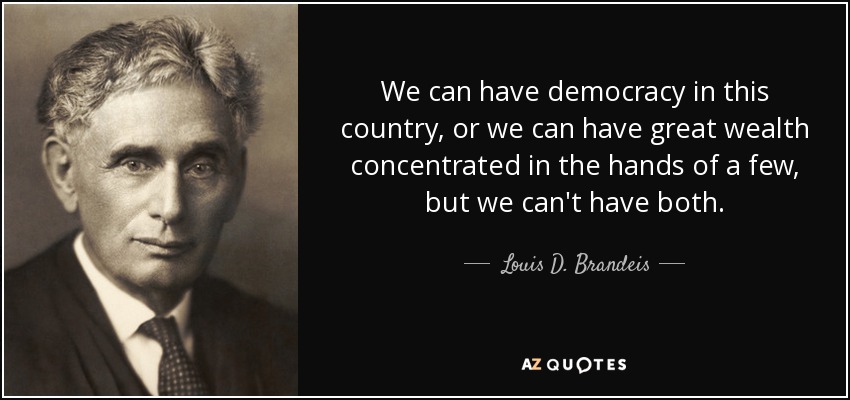
Conspiracy theorists have long talked about a cabal of powerful men who orchestrate world events. Today, even mainstream media has popularized the term “Russian Oligarchs”. But does an American oligarchy exist?
First, some definitions (from Merriam-Websters Dictionary):
Oligarchy: (1) government by the few, (2) a government in which a small group exercises control especially for corrupt and selfish purposes
Plutocracy: government by the wealthy
Under plutocracy, Websters adds an interesting Did You Know factoid:
Ploutos was Greek for “wealth”, and Plouton, or Pluto, was one of the names used for the Greek god of the underworld, where all the earth’s mineral wealth was stored. So a plutocracy governs or wields power through its money.
One need not go down the conspiracy rabbit hole to explore how the rich and powerful get – and stay – rich and powerful. Examples from mainstream American history include the Robber Barons, the Rockefellers and Standard Oil. Of course, these monopolies were broken up long ago. But might there be a modern story of the concentration of wealth and power?
In this post, I recommend some books that shed light on that modern story. There are many other sources, but these were carefully chosen based on the following merits:
- These books are not theoretical. They do not speculate on how money and power might be used to manipulate events. Instead, these authors provide specific, documented accounts of oligarchic machinations from history – things that actually happened. There are names, dates, places.
- They cover a wide historical berth – many decades covering the modern era of World War II (and earlier) to the present (mid-2000s).
- They reference numerous and credible source material that can be verified (notes with links).
- Their tone is even-keeled and professional, not inflammatory.
- They are well-written/narrated and enjoyable to read/listen to. (I listen to audiobooks a lot. Because of the amount of detail in these particular books, I used both the audio and print/Kindle versions. The audio provided great storytelling, while the print/Kindle allowed me to study further.)
- They are organized so you don’t have to “swallow the ocean” as they say. Covering many decades, people, places and historical accounts, these are not fast reads. But seen as a collection of fascinating stories (which they are), these books can be digested in small doses.
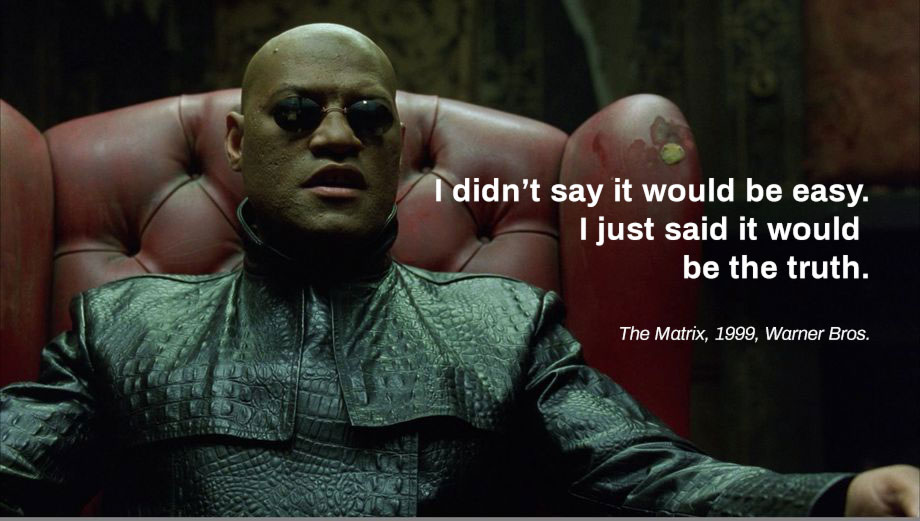
One cautionary note: Some of the information contained in these books will likely shock and anger you. We are, after all, dealing with the topic of power: it’s use and abuse. But it’s important to understand how power operates – knowledge is our first line of defense against it’s abuse.
The belief that an American oligarchy/plutocracy exists lies not in subscribing to some conspiratorial theory, but in a review of historical events. Only then can you decide for yourself the veracity of such provocative claims.
The Devil’s Chessboard by David Talbot
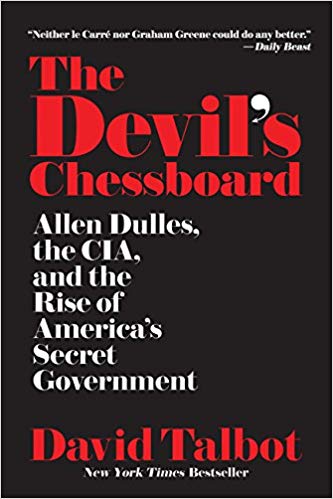
I originally bought this book as an entertaining conspiracy theory read. Instead, I got a sweeping and detailed historical tour de force. David Talbot’s The Devil’s Chessboard is like your favorite spy novel, biography and historical fiction all rolled into one. Except it’s all true! Using declassified official documents, news reports, magazine articles, biographies, memoirs, letters, and interviews (over 600 reference notes), The Devil’s Chessboard takes us on a fascinating (and often disturbing) journey through Allen Dulles’ life – a life that, though ended in 1969, continues to have a global impact.
A Dynasty is Born
Allen Dulles was Director of the Central Intelligence Agency (CIA) from 1953-1961. During World War II, he built up a vast network of contacts in Europe, which he leveraged before, during and after his CIA reign. But not all of his orchestrations were in service to the United States of America. Instead, his empire of operatives more often served to foster and protect the financial and industrial dynasties that sustain America’s plutocracy – even when contrary to US policy. I admit this is quite a loaded proposition, but after reading The Devil’s Chessboard you will be hard-pressed not to come to the same conclusion.
Questions of Loyalty
Key to understanding Allen Dulles’ pivotal role in American plutocracy is Sullivan & Cromwell, the Wall Street law firm where he and his brother Foster launched their careers. Here they represented some of the most powerful companies in America, including Standard Oil and United Fruit Company. These connections made the Dulles brothers highly loyal to the very wealthy – the plutocrats. From bankrolling and manipulating (and assassinating?) domestic politicians to orchestrating coups in other countries, whenever the interests of the plutocrats were threatened, the Dulles brothers maneuvered to protect them.
Here are just a few of the many, many examples covered in the book:
- Upon taking office in 1953, President Eisenhower appointed Allen Dulles to head the CIA and his brother Foster Dulles as Secretary of State. Soon after, the Dulles brothers rescued their oil industry clients from a Justice Department antitrust case launched during the Truman administration. They arranged to have the price-fixing case “reduced from a criminal to a civil charge and conveniently transferred to Foster Dulles’s jurisdiction, the first time in U.S. history that an antitrust case was handed over to the State Department for prosecution. Foster argued that the case had national security implications, and it quietly disappeared, leaving Big Oil unscathed.”
- In 1954 Guatemala, popularly-elected President Jacobo Arbenz planned to redistribute farmland back to the people. At the time, “70 percent of which was in the hands of 2 percent of land owners.” This land reform threatened the monopoly of longtime Dulles client, the United Fruit Company. In response, Dulles planned to remove Arbenz from power. Here the CIA pulled out all the stops: accusations of communism, bribery, physical threats, bombing raids. When the CIA bought out Arbenz’ own military, he was forced to flee the country, never to return. Subsequent installation of “the CIA-backed regime of Castillo Armas . . . was the beginning of a blood soaked era that would transform Guatemala into one of the twentieth century’s most infamous killing fields.”
The Dynasty Lives On
Allen Dulles essentially created the “military-industrial complex” that President Eisenhower warned us about when he left office in 1961, likely out of regret for his role in enabling it. Today, it has grown beyond the Dulles brothers’ wildest dreams. The National Security Administration (NSA), Defense Intelligence Agency (DIA) and private security firms have joined the CIA and FBI in establishing a “national security state” that threatens to subvert American democracy.
Conspiracy theory? Read The Devil’s Chessboard and decide for yourself.
For book details and purchase options, you can support my site by using this link to Amazon. Thank you!
John Perkins: Economic Hit Man
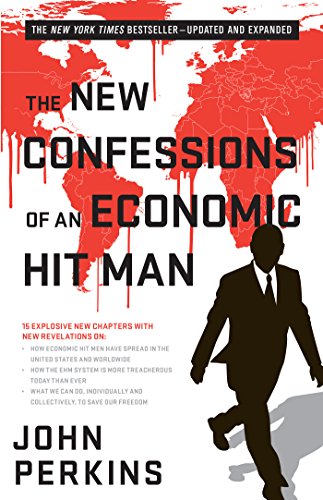
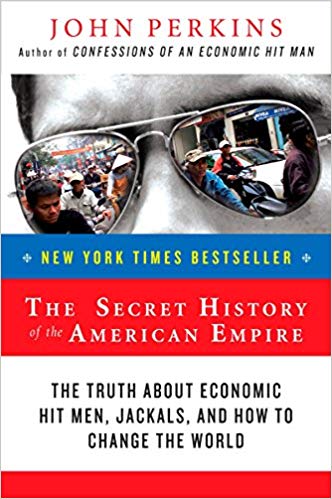
The “military-industrial complex” which Allen Dulles helped build in the 1950s has grown into what author and former “Economic Hit Man” John Perkins calls a “corporatocracy – vast networks of corporations, banks, colluding governments, and the rich and powerful people tied to them.” This system is designed to concentrate wealth and power into very few hands – at the expense of the environment and everyone else. Having been part of that system, John Perkins provides a rare insider’s view of how it works.
The System
From 1971-1980, Perkins was employed by Chas. T. Main, Inc. (MAIN), an international consulting firm that conducted infrastructure and engineering studies, primarily in developing nations like Ecuador and Indonesia. While the idea of improving poor countries’ standard of living with better electrical grids and highways sounds good, the actual intent and outcome tells a different story.
As Perkins explains: “The unspoken aspect of every one of these projects was that they were intended to create large profits for the contractors, and to make a handful of wealthy and influential families in the receiving countries very happy, while assuring the long-term financial dependence and therefore the political loyalty of governments around the world. The larger the loan, the better. The fact that the debt burden placed on a country would deprive its poorest citizens of health care, education, and other social services for decades to come was not taken into consideration.”
What is an “Economic Hit Man”?
Though the official job titles may be simply “economist” or “engineer” or “analyst”, firms like MAIN actually employ “Economic Hit Men” (EHM), (an insider term), who ensure the “success” of these projects through inflated estimates, political payoffs and extortion among other control tactics. If these pressure tactics don’t work, the “jackals” are brought in to apply more extreme measures – including assassinations.
Confessions: The View from Inside
John Perkins spent nearly a decade as an EHM, operating in vulnerable countries across the globe. After he got out, he wanted the world to know what was really going on. Dodging threats and bribes for 20 years, he finally published Confessions of an Economic Hit Man in 2004. The book was his insurance, and it worked. He went on to release The Secret History of the American Empire in 2007, which expands upon Confessions by focusing specifically on American imperialism in different regions – Asia, Latin America, The Middle East and Africa. Recently, in 2016 he released the updated New Confessions of an Economic Hit Man, in which he supplements his original story with valuable insights into world events in the 21stcentury from his unique understanding as a former EHM.
Hope for Change
While the stories Perkins shares are gloomy, he maintains hope that things can change – that we can evolve out of this destructive “death economy” based on debt, fear and violence into a “life economy” that sustains the planet and all of us living on it. In addition to opening our eyes to the problem, he provides options for solutions. There are things we can do to turn things around.
Towards that end, I highly recommend these two books. His stories are both personal and political. Though his official role as an EHM was to develop economic analyses that would benefit the corporatocracy, he took the unusual step of getting to know the people in the countries where he did business. Thus, we are gifted with an important inside look at both the unjust system and the people most harmed by it. We owe it to ourselves to learn about the price paid for the American way of life.
For book details and purchase options, you can support my site by using the following links to Amazon. Thank you!
Dark Money by Jane Mayer
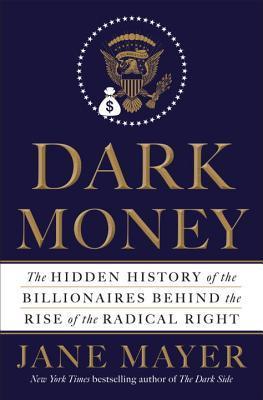
Most of us have some notion that the wealthy hold considerable sway in American politics. But exactly how do they wield their political power? With dozens and dozens of specific examples, Jane Mayer’s Dark Money sheds extraordinary light on the plutocrats playbook.
Meticulously researched with hundreds of references from across the political spectrum, Dark Money explains – with specific examples – the various mechanisms plutocrats use to steer government policy in the direction of their business interests. Based on the book, I created the following diagram:
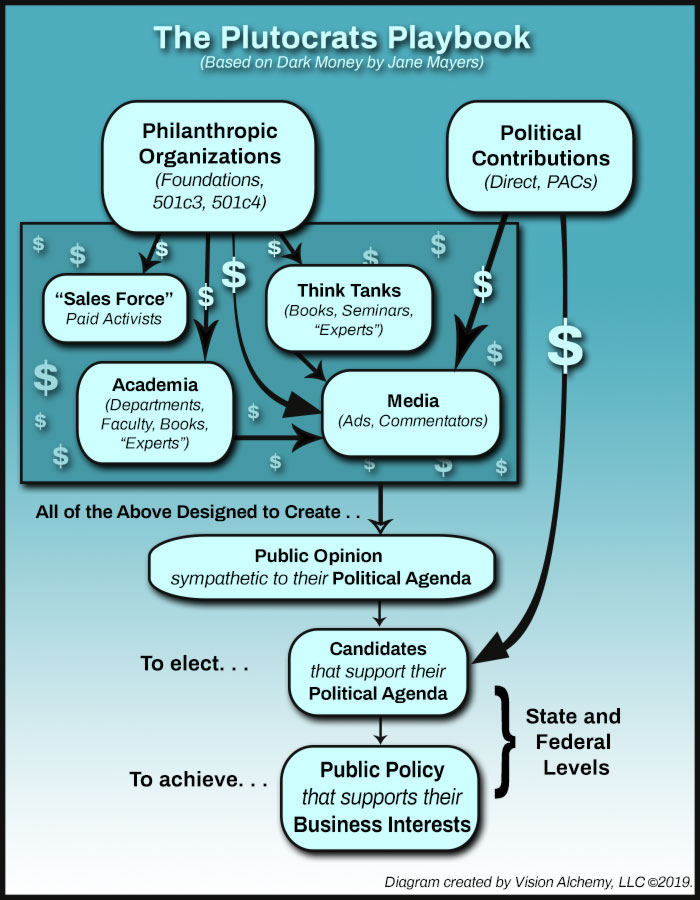
One of the most insidious methods of camouflage used by the plutocrats is deceptively naming their various organizations. Using Orwellian tactics to hide their true agenda, they have christened scores of charitable organizations, think tanks, and academic departments with innocuous names like “Citizens for a Sound Economy,” “Americans for Prosperity,” and “Center for Patient Rights” Mayer quotes one donor as admitting, “if we said openly that we were re-teaching the economics of the free market, it might enable our enemies to question the charitableness of our motives.”
While my flowchart will give you an idea of how plutocrats operate, only by reading the book will you get a true sense of the scope of their power. Even if you agree with the conservative political agenda, you owe it to yourself to understand the people and motivations behind that agenda. Only then can you honestly decide whether or not those policies are in your best interest.
For book details and purchase options, you can support my site by using this link to Amazon. Thank you!



